Yamaha FZ750 Geneses
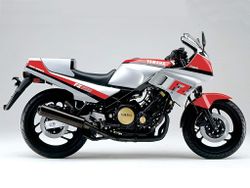 |
|
| Yamaha FZ750 Geneses | |
| Manufacturer | |
|---|---|
| Production | 1985 |
| Engine | Four stroke, transverse four cylinder, DOHC, 5 valves per cylinder. |
| Compression ratio | 11.2:1 |
| Top Speed | 233.3 km/h / 145 mph |
| Ignition | Electronic triggered |
| Spark Plug | NGK, DR8ES-L |
| Transmission | 6 Speed |
| Frame | Aluminum, twin spar |
| Suspension | Front: Telescopic forks non adjustable. Rear: Monocross with single shock adjustable for preload. |
| Brakes | Front: 2x 270mm discs 2 piston calipers Rear: Single 270mm disc 1 piston caliper |
| Front Tire | 120/80 V16 |
| Rear Tire | 130/80 V18 |
| Seat Height | 782 mm / 30.7 in |
| Weight | 209 kg / 460.7 lbs (dry), 222 kg / 489.5 lbs (wet) |
| Recommended Oil | Yamalube 10w-40 |
| Fuel Capacity | 22 Liters / 5.8 gal |
| Manuals | Service Manual |
It could reach a top speed of 233.3 km/h / 145 mph.
Engine[edit | edit source]
The engine was a Liquid cooled cooled Four stroke, transverse four cylinder, DOHC, 5 valves per cylinder.. The engine featured a 11.2:1 compression ratio.
Drive[edit | edit source]
Power was moderated via the Wet, multiple discs, cable operated.
Chassis[edit | edit source]
It came with a 120/80 V16 front tire and a 130/80 V18 rear tire. Stopping was achieved via 2x 270mm discs 2 piston calipers in the front and a Single 270mm disc 1 piston caliper in the rear. The front suspension was a Telescopic forks non adjustable. while the rear was equipped with a Monocross with single shock adjustable for preload.. The FZ750 Geneses was fitted with a 22 Liters / 5.8 gal fuel tank. The bike weighed just 209 kg / 460.7 lbs.
Photos[edit | edit source]
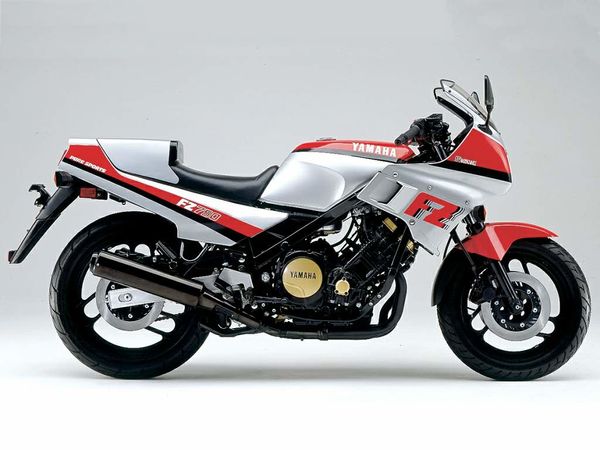 Yamaha FZ750 Geneses
Yamaha FZ750 Geneses
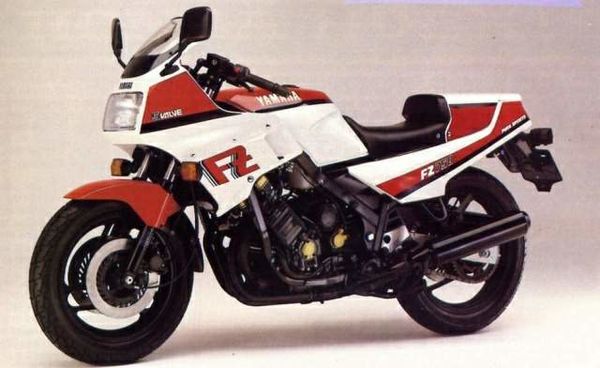 Yamaha FZ750 Geneses
Yamaha FZ750 Geneses
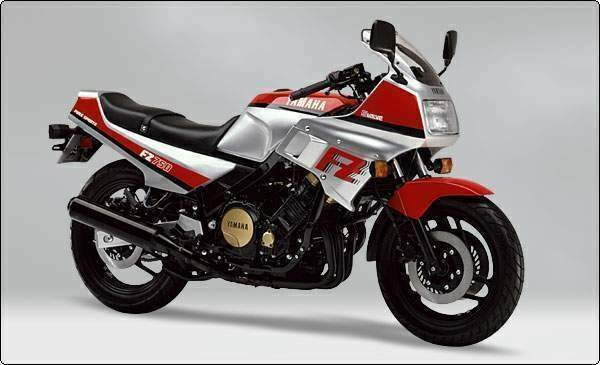 Yamaha FZ750 Geneses
Yamaha FZ750 Geneses
Yamaha FZ750 Geneses
Yamaha FZ750 Geneses
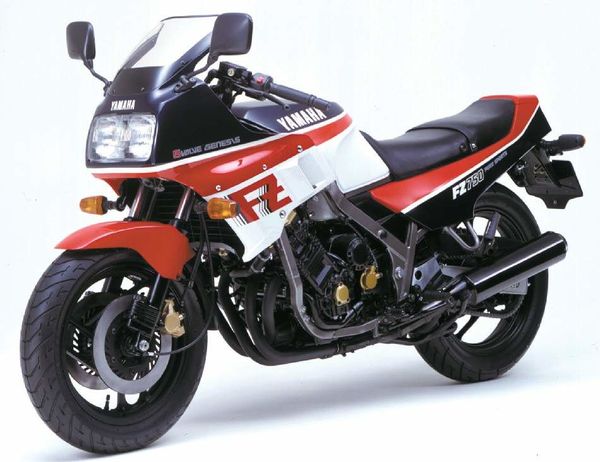
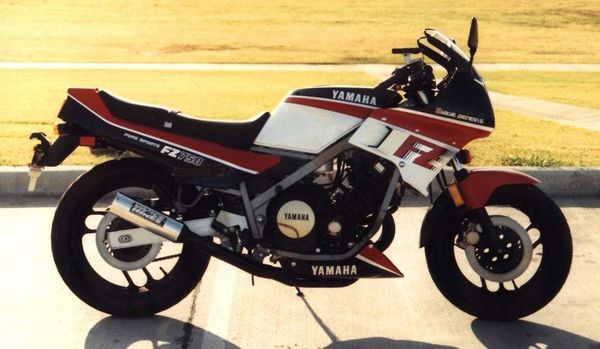 Yamaha FZ750 Geneses
Yamaha FZ750 Geneses
Overview[edit | edit source]
Yamaha FZ 750 Geneses
John Nutting fails to exercise his constitutional right to remain silent
after crimes against the red line aboard Yamaha's FZ750...
The head honchos at Iwata will be the first to admit that Yamaha haven't had a very good decade, so far. Corporate enthusiasm tuned to beating the daylights out of Honda turned sour when it dawned on the Yam execs that Yamahas are not Hondas in the minds of punters. The name Honda is virtually synonymous with motorcycle in most parts of the world and Yamaha found to its cost that to attempt to break the mould is just a recipe for breaking the bank. In a word, Yamaha sales slumped. The repercussions of the collapse echoed long after the replacement of the company President. Revised plans were initiated to put the company back on its feet; a degree of caution characterised the approach. British importers found that, despite the enthusiasm for the RD500LC and the FJ1100, the men from Iwata were sceptical of sales potential, so model allocations for Britain were low, reflecting the squeeze being applied at all levels, not least in the PR department. The result was that Yamaha caught a little bit of a cold in that sales of these two highly desired bikes didn't reach their full potential. It's not a mistake the factory intends to repeat with the FZ750. Yamaha claim that the 5-valve in line four is to be a cornerstone of their range for the next ten years. A touch of cynicism might be acceptable here; after all, the bike trade has seen the pace of change accelerating by the second over the last two to three years, to the extent that to dwell on a new model for any length of time is to miss the impact of its successor. But in an age where 'planned obsolescence' is translated into barnacled cam lobes and anaemic cam chains, Yamaha is keen to impress on us the longevity of this new engine, quoting oil-change intervals of 7,500 miles (!) and valve gear that'll only need the once over at 25,000 miles (!!) It all seems to good to be true, but if it is, we're on the way to the maintenance-free machine. Like the Suzuki GSXR750, which we've yet to try out, the FZ750 makes a claimed lOObhp. That gives the hike a specific power of 133bhp per litre, putting it above Kawasaki's GPz900R's 125bhp/l, and it is only beaten by Honda's VF500F vee-four's 140bhp/litre. Without the means of substantiating that claim on a dyno the only way of finding out if Yamaha were good as their word was to give the bike a good thrashing in Portugal.
Result was that it clocked 145mph at 10,800rpm in top gear on a deserted road
south of Lisbon. By any reckoning that's pretty good for a 750 and it relates
well to the 137mph top speeds accredited to the 90bhp 750's.
Now this top speed may be connected to the bike's remarkably slim profile.
Long proponents of the idea that across-the-frame fours should be as narrow as
possible, Yamaha has gone a step further with the FZ by exploiting water-cooling
so that the pots are closer together and disposing of ignition components on the
end of the crankshaft by using the end faces of the outer crank webs as part of
the pick ups. Overall width of the motor is just 16.3 inches, less than the
factory's own Japan-only air-cooled XJ400 four and about the same as Honda's
vee-fours.
The speed may also be something to do with the neat fairing, claimed to offer
a drag coefficient of just 0.34. It is certainly to do with power, and what's
interesting is that it hasn't been attained by sacrificing flexibility. Though
the FZ750 makes its best power over 7,000rpm, storming out of corners with the
rear wheel drifting, it still pulls well from a walking pace in sixth.
This is where all the criticism of the complexity of five-valves-per-cylinder
hits a block. Ten years ago we had 750cc racing engines putting out 90bhp if
they were lucky, and only then with power bands a couple of thou wide valves.
Valve springs need to be stronger to keep the cam followers on the cams without
damage.
Four-valve layouts have gone a long way to raising the mechanical limits and
improving the combustion chambers shapes which ideally should be a simple
sphere. Honda first used four valves on its racers of the sixties to lighten the
valve gear and raise the rev limits. But combustion was poor because of the
awkWardly shaped piston crowns.
Yamaha claims to have tried to obtain the perfect combustion chamber with a
seven valve arrangement that offered 20,000rpm limits. But, as you'd expect,
fitting this number into a small combustion chamber proved too expensive for a
production machine and eventually after trying six valves, five valves offered
the best compromise.
The benefits are broad. By laying out the three inlet valves so that the
middle one is out of line, and at a different angle from the cylinder axis, but
still operated from the camshaft by a bucket follower like the other two, the
combustion chamber shape needn't be complex. Indeed, Yamaha claims an 11.2 to 1
compression ratio which is remarkably high and shows that the combination of a
slightly dished piston crown and centrally placed spark plug in a symmetrical
chamber is the way to go.
Three small valves can flow more air than two and in the FZ's case they need
less lift and opening timings to achieve it; that's the reason why the motor is
more flexible than you'd expect. The three valves are individually lighter, so
the point at which they start to float is higher up the rev range. Yamaha placed
the red-line of the FZ at 1 l,000rpm with a rev limiter operating at 1 l,800rpm.
Because the valves are lighter, they need less strong valve springs so not
only is the power absorbed by the valve gear lower, the camforms needn't be so
radical. Wear is reduced as a result.
Straight, uninterrupted inlet ports have always been the goal for obtaining
high power from four-strokes. Trouble is they're difficult to fit into bikes
without getting in the way of the rider. But at the suggestion of the race team
during the FZ's early development the engine was laid forward so that the air
box was where the front of the fuel tank would have been. This meant that both
the inlet ports would be straight and the spacious airbox got large helpings of
cool air.
Yamaha's engineers say that the first prototype engine developed 130bhp at
13,000rpm, a not unlikely figure because they're claiming 330bhp at 13,000 for
their two-litre vee-six car racing engine, and the production lump needed
detuning for the road.
On the road, the FZ is smoother than most straight fours and as expected the
hydraulic clutch and six speed box are slick, though at the expense of slack in
the drivetrain at low speeds.
It's also very low with a sporting riding stance that tucks the rider behind
the screen sufficiently well to keep his helmet out of the breeze. Steering is
light and vice free despite the use of a 16-inch front wheel, a remarkably steep
Steering Head Angle of 64.5 degrees and short trail of 97mm. This is possible
because, says Yamaha, pushing the engine-forward puts more weight onto the
front wheel -almost 50 percent with the bike unladen.
For the scratchers, the news is that there's so much cornering clearance that they'll be in the gutter before anything hard drags despite the use of stickyish Dunlop Japanese tires in fat 120/80V16and 130/80V18 sizes. The rear is an 18-incher so that racers can fit the more widely available slicks in this size. Without doubt, Yamaha is hoping that this bike will form the basis of racers for the world endurance series and TT Formula events. With this in mind there's a tuning kit on the way that'll bring the power back to around 130bhp, making it more than competitive. In almost every respect, the bike's a detuned racer, but, like the RD500LC, the quality of the engine and running gear is such that it offers a refined package for the road. Source Which Bike 1985
| Make Model | Yamaha FZ 750 Geneses |
|---|---|
| Year | 1985 |
| Engine Type | Four stroke, transverse four cylinder, DOHC, 5 valves per cylinder. |
| Displacement | 749 cc / 45.7 cu-in |
| Bore X Stroke | 68 x 51.6 mm |
| Compression | 11.2:1 |
| Cooling System | Liquid cooled |
| Induction | 4x 34mm Mikuni carburetor |
| Ignition | Electronic triggered |
| Spark Plug | NGK, DR8ES-L |
| Starting | Electric |
| Max Power | 105 hp 74.4 kW @ 10500 rpm |
| Max Power Reat Tire | 94 hp @ 9400 rpm |
| Max Torque | 81.4 Nm / 60.0 lb-ft @ 8000 rpm |
| Clutch | Wet, multiple discs, cable operated |
| Transmission | 6 Speed |
| Final Drive | Chain |
| Frame | Aluminum, twin spar |
| Front Suspension | Telescopic forks non adjustable. |
| Rear Suspension | Monocross with single shock adjustable for preload. |
| Front Brakes | 2x 270mm discs 2 piston calipers |
| Rear Brakes | Single 270mm disc 1 piston caliper |
| Front Tire | 120/80 V16 |
| Rear Tire | 130/80 V18 |
| Seat Height | 782 mm / 30.7 in |
| Dry Weight | 209 kg / 460.7 lbs |
| Wet Weight | 222 kg / 489.5 lbs |
| Fuel Capacity | 22 Liters / 5.8 gal |
| Consumption Average | 38.3 mpg / 16.3 km/lit |
| Braking 100 - 0 | 35 m |
| Standing ¼ Mile | 11.3 sec / 116.3 mph |
| Top Speed | 233.3 km/h / 145 mph |
| Road Test | Group Test 1985 Motosprint |